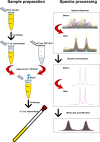Urine metabolome in women with Chlamydia trachomatis infection
- PMID: 29566085
- PMCID: PMC5864028
- DOI: 10.1371/journal.pone.0194827
Urine metabolome in women with Chlamydia trachomatis infection
Abstract
The aim of this study was to characterize the urine metabolome of women with Chlamydia trachomatis (CT) uro-genital infection (n = 21), comparing it with a group of CT-negative subjects (n = 98). By means of a proton-based nuclear magnetic resonance (1H-NMR) spectroscopy, we detected and quantified the urine metabolites of a cohort of 119 pre-menopausal Caucasian women, attending a STI Outpatients Clinic in Italy. In case of a CT positive result, CT molecular genotyping was performed by omp1 gene semi-nested PCR followed by RFLP analysis. We were able to identify several metabolites whose concentrations were significantly higher in the urine samples of CT-positive subjects, including sucrose, mannitol, pyruvate and lactate. In contrast, higher urinary levels of acetone represented the main feature of CT-negative women. These results were not influenced by the age of patients nor by the CT serovars (D, E, F, G, K) responsible of the urethral infections. Since the presence of sugars can increase the stability of chlamydial proteins, higher levels of sucrose and mannitol in the urethral lumen, related to a higher sugar consumption, could have favoured CT infection acquisition or could have been of aid for the bacterial viability. Peculiar dietary habits of the subjects enrolled, in term of type and amount of food consumed, could probably explain these findings. Lactate and pyruvate could result from CT-induced immunopathology, as a product of the inflammatory microenvironment. Further studies are needed to understand the potential role of these metabolites in the pathogenesis of CT infection, as well as their diagnostic/prognostic use.
Conflict of interest statement
Figures


References
-
- Senior K. Chlamydia: a much underestimated STI. Lancet Infect Dis 2012;12: 517–518. - PubMed
-
- Haggerty CL, Gottlieb SL, Taylor BD, Low N, Xu F, Ness RB. 2010. Risk of sequelae after Chlamydia trachomatis genital infection in women. J Infect Dis 2010;201: S134–S155. doi: 10.1086/652395 - DOI - PubMed
-
- Elwell C, Mirrashidi K, Engel J. Chlamydia cell biology and pathogenesis. Nat Rev Microbiol 2016;14: 385–400. doi: 10.1038/nrmicro.2016.30 - DOI - PMC - PubMed
-
- Mehlitz A, Eylert E, Huber C, Lindner B, Vollmuth N, Karunakaran K, et al. Metabolic adaptation of Chlamydia trachomatis to mammalian host cells. Mol Microbiol 2017;103: 1004–1019. doi: 10.1111/mmi.13603 - DOI - PubMed
-
- Omsland A, Sager J, Nair V, Sturdevant DE, Hackstadt T. Developmental stage-specific metabolic and transcriptional activity of Chlamydia trachomatis in an axenic medium. Proc Natl Acad Sci U S A 2012;109: 19781–197785. doi: 10.1073/pnas.1212831109 - DOI - PMC - PubMed
MeSH terms
LinkOut - more resources
Full Text Sources
Other Literature Sources
Medical

